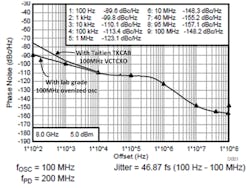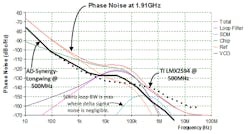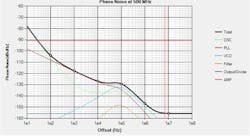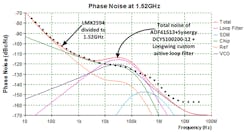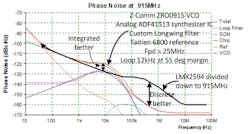Series: Ultra-Low-Noise Synthesizer Design
Download this article in PDF format.
This article is the fifth and concluding installment in this series on ultra-low-noise synthesizers. Part 1 introduced higher-order phase-locked-loop (PLL) design, while Part 2 reviewed noise sources. Part 3 analyzed noise shaping in the loop followed by Part 4, which presented commercially available parts for the low-noise PLL designer.
Longer and more detailed versions of these articles are available for download at www.longwingtech.com. This final article is intended to focus on the noise-performance results and tradeoffs in design examples using the low-noise techniques and parts presented earlier. Here, we compare the best performance available with fully integrated synthesizers to that which is possible with discrete voltage-controlled oscillators (VCOs) and external active filters.
Example 1: Fully Integrated High-Performance Synthesizer
An outstanding example of a state-of-the-art device of this type is Texas Instruments’ (TI) LMX2594/95 (LMX2595 is the higher-frequency version). Its performance will be shown both here and in the phase-noise graphs of several other solutions for comparison. The phase noise at an output frequency of 8 GHz is shown in Figure 1 (taken from the datasheet). Design and phase-noise prediction may be quickly performed using the “PLLatinumSim” program found on TI’s website. For more detailed control of the design than the assumptions in this program, the author recommends the methods developed earlier in this series using an analysis program such as Mathcad.
1. Depicted is the phase noise of the LMX2594 at an output frequency of 8 GHz. The loop bandwidth is about 300 kHz.
At 8 GHz, the LMX2594 on-die VCO has an open-loop phase noise of approximately −80 dBc/Hz at 10-kHz offset. This number represents a good but not great noise level. It’s good enough to allow for effective suppression in the loop to approach the device’s industry-leading Pn1Hz of −235 (fractional mode). However, it’s not possible to achieve suppression all the way down to the limit implied by this floor. That’s because the VCO noise and 1/f noise in the synthesizer are too high to allow that with the maximum loop bandwidth on the order of 300 kHz.
Despite this internal noise limit, the LMX2594 does deliver quite excellent performance, which is a challenge for discrete VCO synthesizers to beat. The integrated noise and adjacent-channel-rejection limits of the LMX2594 are shown in the long-form article.
Example 2: Discrete Land Mobile Synthesizer
Land-mobile radio is an application that requires low phase noise due to its closely spaced 12.5-kHz channels (see long form of Part 3). Let’s now compare the LMX2594 with the more classic low-noise discrete VCO approach.
VCO: For this relatively narrowband application, we select the Synergy Microwave DCRO178205-10 VCO that covers 1,785 to 2,060 MHz.
Synthesizer: Analog Devices ADF41513, Pn1Hz = −231 in fractional mode. Using this synthesizer, we will perform basic analysis and simulation with the convenient Analog Devices “SimPLL” program.
Crystal reference: Taitien TKCAB 100-MHz voltage-controlled temperature-compensated crystal oscillator (VCTCXO).
Loop filter: Custom Longwing active implementation that provides 0 to 12 V.
Loop: Bandwidth of 50 kHz and phase margin of 60 degrees.
We see in Figure 2 that the Synergy-Analog solution is similar to the LMX2594 up to about 3 kHz, but it’s inferior from 3 to 100 kHz by as much as 8 dB. This solution then achieves superior performance above 100 kHz. The superiority of the Synergy-Analog solution with a custom Longwing active filter at 200 kHz is about 6 dB before increasing to about 16 dB at 1 MHz.
2. A high-quality discrete land-mobile synthesizer with 50-kHz bandwidth is compared to TI’s LMX2594 with 300-kHz bandwidth.
From Figure 2, this discrete synthesizer divided down to about 500 MHz would achieve an LdB(flat) of about −129 dBc/Hz. It meets the 12.5-kHz adjacent-channel-noise requirement derived in Part 3 with a margin of 4 dB on top of the 10 dB that’s built into that requirement. However, while this approach satisfies noise requirements, it’s less flexible and moderately more expensive than a fully integrated synthesizer solution such as the LMX2594. Thus, this approach is really only justified if moderately lower power consumption and better far out noise are required.
Example 3: Handheld Land Mobile Synthesizers with Integrated VCOs (LMX2572 and LMX2571)
The land-mobile examples discussed above are suitable for vehicle or base-station radios. However, the higher current of the integrated VCO LMX2594 (approximately 340 mA) and higher tune voltage of the DCRO178205-10 VCO (12 V) make them less suitable for handheld transceivers.
A possible fully integrated solution with generous safety margin on noise performance is TI’s LMX2572. This part, intended for battery-powered applications, has a supply requirement of 3.3 V at 75 to 86 mA. The phase noise shown in Figure 3 corresponds to a 6-GHz VCO that’s divided by 12 to 500 MHz for land-mobile use.
3. Shown is the LMX2572 phase noise at 500-MHz output with Taitien’s TKCAB 100-MHz reference. The loop bandwidth is 150 kHz.
This device meets the land-mobile requirement of average LdB of −125dBc/Hz from 6.25 to 18.75 kHz with about 3 dB of margin. As the requirement has a safety margin of 10 to 12 dB built in, the safety margin here likely approaches 15 dB over statutory requirements.
The LMX2571 is an even lower power TI delta-sigma synthesizer designed for battery-powered applications. This synthesizer has integrated VCOs, but it can also accept external VCOs. In external VCO mode, its power requirements can extend down to 9 mA. It can come within about 5 dB of the adjacent-channel-noise performance of the LMX2572, which is generally sufficient for portable radios.
Example 4: Discrete Broadband Synthesizer from 1 to 2 GHz (Cellular Base Station)
The cellular-base-station application is one that may need superior far out noise compared to what’s provided by an integrated VCO. Here, we can afford the moderately higher price of the necessary low-noise active loop filter and low-noise higher-voltage power supplies.
VCO: For this wider-band application we select the Synergy DCYS100200-12 VCO, which covers a frequency range of 1 to 2 GHz. This part is among Synergy’s lowest normalized-noise performing octave-range VCOs. It does require 12 V for power and 28 V for tuning. Figure 4 show noise for a range of 1.15 to 2 GHz, as 1.15 GHz is the lowest frequency that allows an Fpd (phase detector frequency) of 50 MHz.
4. This is the 1.15- to 2-GHz noise using the Synergy DCYS100200-12 VCO, Analog Devices’ ADF41513 synthesizer chip, Taitien’s TKCAB 100-MHz VCTCXO, and the Longwing active loop filter.
Synthesizer: Analog Devices ADF41513, Pn1Hz = −231 in fractional mode.
Crystal reference: Taitien TKCAB 100-MHz VCTCXO.
Loop filter: Custom Longwing active implementation that provides 0 to 28 V.
Loop: Bandwidth of 55 kHz and phase margin of 60 degrees.
Here, we note that this discrete solution is nearly identical to the integrated LMX2594 solution at close-in frequencies—it’s inferior from 50 to 200 kHz and then superior beyond about 200 kHz. The superior far-out performance would be the main reason to select this design over the moderately more cost-effective fully integrated solution. The adjacent-channel implications are given in the long form.
Example 5: Discrete VCO Synthesizer (RFID) from 902 to 928 MHz
Radio-frequency identification (RFID) is an application that calls for outstanding phase noise in the reader. Superb VCOs are available for this application.
VCO: Z-Comm’s ZRO0915 is the lowest normalized-noise VCO on the market with significant tune range. Only very narrow SAW-based oscillators have lower noise than this device.
Synthesizer: Analog Devices ADF41513, Pn1Hz = −231 in fractional mode.
Crystal reference: Taitien 6800 ovenized part.
Loop filter: Custom Longwing active implementation that provides 0 to 12 V.
Loop: Bandwidth of 12 kHz and phase margin of 55 degrees.
Despite the very low noise of the ZRO0915, the limit of 25 MHz for Fpd when using a 100-MHz reference oscillator makes the noise performance around the loop bandwidth inferior to the LMX2594 solution (Fig. 5). Beyond the loop bandwidth, the performance is significantly superior.
5. The Z-Comm ZRO0915 ultra-low-noise VCO locked up by the ADF41513 synthesizer with Taitien’s 6800 100-MHz reference. The 12-kHz loop bandwidth employed here is the maximum that can be used while keeping the delta-sigma noise invisible. The Longwing ultra-low-noise active filter used here improves noise performance around the loop bandwidth by about 2 dB over a standard low-noise active filter.
Final Summary
This five-part series has centered on creating a detailed understanding of noise sources, shaping, and performance in modern synthesizer design. A key issue was if and when synthesizers designed with the classic method of packaged VCOs could outperform the latest fully integrated synthesizers with on-die VCOs. The answer is that, for most applications, the integrated noise VCO performance is perfectly fine, though for some portable applications the power consumption may not be acceptable.
However, beyond the loop bandwidth that’s generally in the range of 40 to 400 kHz, the discrete VCO approach is still superior by amounts that can exceed 20 dB. This is important in some applications. However, few VCOs have that large of a performance advantage over integrated VCOs. And to the author’s knowledge, there are currently no VCOs above 4 GHz for which the full advantages of the high-bandwidth delta-sigma synthesizer can be applied. These architectural advantages and how they are best applied are discussed in detail in the earlier parts of this series.
For the discrete VCO approach to regain its previous market dominance in low-noise applications, VCOs must achieve low normalized phase noise at frequencies above 4 GHz that’s comparable to the performance of the best lower-frequency VCOs. This possibility is explored in the long form of this article.
Series: Ultra-Low-Noise Synthesizer Design
Long forms of these articles that contain more detail are posted at www.longwingtech.com.
Farron Dacus is an RF design consultant in Dallas, Texas. He received his BSEE and MSEE from the University of Texas, and has over 30 years of experience ranging from ICs to circuits to systems in low-noise RF, short-range radio / IoT, cellular, military communications, and aircraft radios. He may be reached at [email protected].
References
1. “Design Methods of Modern Ultra-Low Noise Synthesizers,” Farron Dacus, Microwaves & RF, Dec. 2018.
2. “Noise Sources in Ultra-Low-Noise Synthesizer Design,” Farron Dacus, Microwaves & RF, Feb. 2019.
3. “Noise and its Shaping in Ultra-Low-Noise Synthesizer Design,” Farron Dacus, Microwaves & RF, Mar. 2019.
4. “Key Parts for Ultra-Low-Noise Synthesizer Design,” Microwaves & RF, Oct. 2019.

